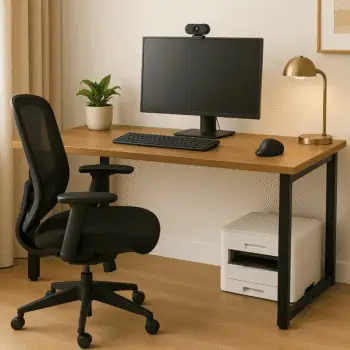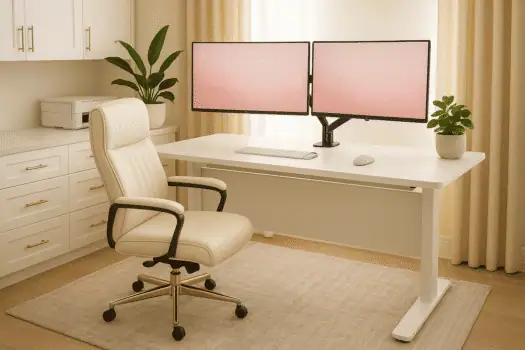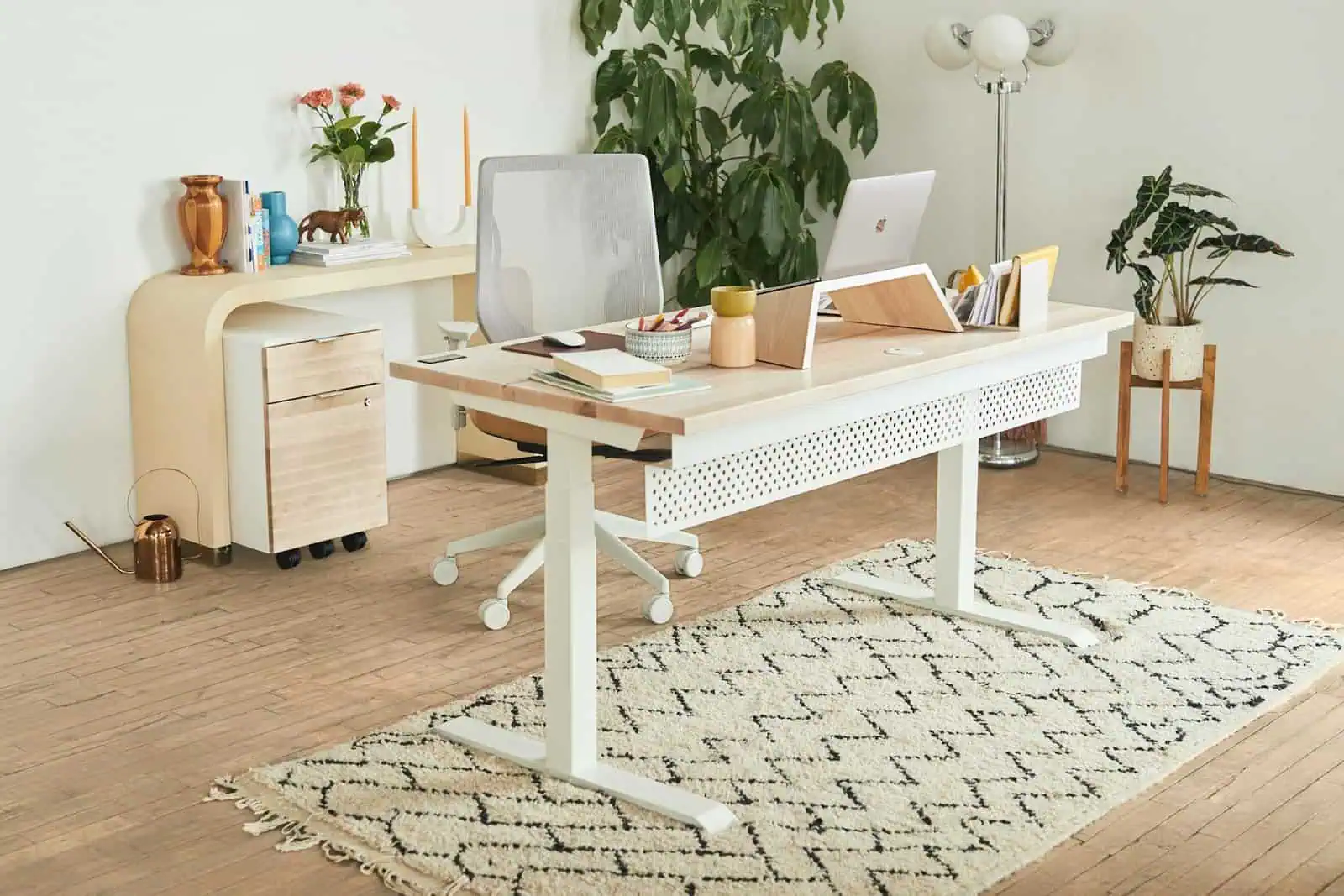The idea of working from home often comes wrapped in images of cozy blankets, coffee mugs, flexible hours, and a laptop perched perfectly on a stylish desk. However, behind the Instagram-worthy setups lies a question that many people overlook: how much does it actually cost to create a functional, comfortable, and productive home office?
Whether you’re transitioning to remote work for the first time, freelancing full-time, or simply using your living room for a new online business or side project, the price tag can vary wildly. From budget-friendly basics to high-end investments, knowing what you’ll need and what you can save money on can make all the difference.
No matter your budget, there are plenty of popular office desk designs to choose from to really personalise your office, from minimalist desk designs to bright, dopamine-inducing colour schemes, or the timeless Scandinavian style.
The Cheapest, most affordable Option – “Laptop at the Table”

What it is: If you already own a laptop, this is a great starting point and the most cost-effective method there is.
Use what you already have as your desk and chair – whether it’s the kitchen table, a side table, a simple folding desk, or even your sofa with the laptop on your lap. Then, add a few inexpensive comfort upgrades, like a laptop stand and a basic mouse, and you’re all set!
Typical shopping list & rough costs:
- Laptop you already own (or entry-level, if needed): £0–£500
- Laptop stand or a stack of books to get the laptop higher up for eye level: £0–£25
- Optional external mouse (wired or Bluetooth): £10–£30
- Cushion or folded towel for chair comfort: £0–£10
- Simple noise reduction (earbuds you already own): £0–£30
- Use a fold-out table, tray, or even a TV dinner tray as a makeshift desk or sit at your dining room table.
Total estimate: £10–£595 (often closer to £50 if you already have a laptop)
Pros:
- Very low cost and almost no setup time.
- Flexible: Pack it away at the end of the day if your “office” is your dining room. Use your laptop in different free wifi locations, such as the library or coffee shops, for a change of scenery (just be wary that money may need to be spent on drinks/food to work in these locations)
- Good for short spells or testing if home working suits you.
Cons:
- Comfort is usually poor. Hunching over a laptop strains your neck and shoulders and wrist.
- Shared spaces can be noisy and busy, which can hinder focus and impact your appearance on calls.
- A budget laptop can be slow and not very effective for long working days.
- Cable mess. The Laptop charger cable and mouse cable can be messy. Frequent packing/unpacking can take up time and attention.
- The cost of eating out and making drink purchases in coffee shops can soon add up.
- No real storage: papers and chargers can become cluttered and piled up in different areas of the house.
- Travelling to and from different locations to work can be both costly and time-consuming.
Motivation & effectiveness:
- Motivation can dip because there is no clear “work zone.”
- Your Focus can suffer with people walking around in coffee shops, or dishes in view, a TV nearby; it is easy to become distracted. At home, when many other household chores may need doing or more exciting activities are available, you are more likely to leave the work that needs doing on your laptop to attend to other things.
- Blurred boundaries – Home is usually linked with rest, so it’s harder for your brain to “switch into work mode.” It can also be very monotonous to be in the same environment with no real structure day in and day out.
- Poor posture from sitting in a slouched position can have lasting negative effects on your back, neck joints, and muscles.
- Video calls: You may be backlit (window behind you) or in shadow and hard to see on video calls, and the background may be messy or too personal,which is not ideal during an important client call.
Who this is option best suited for:
- Students, interns, or anyone on a tight budget.
- People who need a temporary or occasional home office.
- Freelancers.
In order to make this setup work well, you need to remember these key features.
- Ergonomics: Raise the screen to eye level; use an external keyboard/mouse if you can.
- Ventilation: Keep airflow under the laptop to prevent overheating.
- Cables: Tidy cables with clips or ties.
- Lighting: Use natural light.
- Positioning: Reduce glare by angling your screen away from windows.
The Middle Option “A Solid Desk & Comfortable Chair”

What it is: This is the sweet spot for most people: a steady desk, a truly comfortable chair, and a couple of high-impact add-ons (a monitor instead of a laptop, a keyboard, and a decent lamp).
It’s where you feel a real jump in comfort and output without going all-in on custom storage.
Typical shopping list & rough costs:
- Mid-range desk, The price will depend on several features such as build quality, adjustability, and lumbar support (120–160 cm wide): £100–£300
- Comfortable chair (height adjustable and lower-back support): £50–£450
- A cheap to midrange computer pc can be customised in the long run. If working on emails, documenting, and browsing, then a cheaper computer will do just the job, and a more expensive one is necessary for editing pictures, gaming, and multitasking with faster specs. £300-750+
- Monitor £100- £300 for a mid-range monitor with a 24-inch to 30-inch range. A monitor can be used with a laptop if you already own a laptop to extend your display or improve your viewing experience.
- Keyboard + mouse combo: £30–£80
- Monitor arm (optional but useful as it allows for easy height adjustment and better posture): £35–£90
- Desk lamp (adjustable, low glare): £20–£60
- Basic cable tidy kit (clips, tray): £10–£30
- Laptop stand or dock (if choosing a laptop instead): £20–£120
- Ergonomic foot rest reduces pressure on your lower back and legs. £15-£40
- A printer (optional but useful) £50-£300 + depending on what you want to use it for.
Total estimate: £730–£2,220 (most end up around £700–£900)
Pros:
- Big comfort upgrade: Using a computer chair and an eye-level screen reduces strain and improves posture.
- Productivity boost from a larger screen and better typing setup.
- Better calls: steady camera angle, simpler background, and good light.
- Clear work zone: a dedicated desk and area to work helps to keep a routine.
Cons:
- Needs space; not ideal if you can’t spare an area in your house.
- Assembly time.
- limited storage; papers may live in a drawer unit or box rather than an organised space.
- Bigger upfront cost
Motivation & effectiveness:
- Motivation rises with comfort: fewer aches and fewer small hassles.
- Effectiveness improves with a bigger screen, and a pc over a laptop, you feel more motivated on a desk you like using.
- You start tuning your setup (keyboard feel, lamp height, monitor position), and those small wins add up.
- Better posture improves performance.
- Video calls – You can set a steady, professional frame: camera at eye level, tidy background, warm desk light. With steadiness and lighting sorted, you come across as more confident and clear.
Who this is for:
- Full-time remote workers, hybrid workers on home days, and freelancers.
- People who want real comfort and improved motivation.
The Full Office set up – “Storage, Sound, and Finishing Touches”

What it is: A space built for long days: a standing desk, perhaps, high-end chair, useful storage for long-term paperwork and improved security, simple sound treatment, and lighting that makes you look good on camera.
The focus is comfort, quiet, and a clean look. For this, you would need a good, large free space in your home or, better yet, a spare room you can call your office.
Typical shopping list & rough costs:
- Standing desk (motorized): £150–£1500
- Premium chair (good lower-back and armrest adjustments): £250–£1,100+
- Dual 27″ monitors or a single 32″ 4K: £300–£900+
- Desktop PC £400-£750+
- Monitor arms (single or dual): £70–£200
- Drawer unit + shelves/cabinet: £120–£500
- Simple sound fixes (panels, rug, door seal): £80–£200
- Better webcam or phone-as-webcam mount: £40–£100
- Ergonomic mouse and keyboard £40
- USB mic or headset for clear audio: £40–£150
- Docking hub £40-£200
- Decor (plant, framed prints): £10–£150
- Modesty panel to hide unsightly cables £60
- Cable raceways, under-desk tray, power strips: £30–£80
- Printer (depending what your usage) is £50-£300
Total estimate: £2,220–£6,130 (many land £2,000–£3,000)
Pros:
- Top comfort for long days: the option to stand helps with energy.
- Quiet, focused room with basic sound fixes (less echo, less outside noise).
- On-camera upgrade: even light and clear audio make you look and sound sharp.
- Real storage: everything has a spot, so your desk stays clear and your mind calm.
Cons:
- Cost: bigger up-front spend.
- Time and planning: measuring, ordering, building, and arranging.
Motivation & effectiveness:
- Strong motivation benefits: walking into a space that feels intentional sets the tone for deep work.
- Output climbs with smooth workflows (plug in once; everything wakes up).
- Better steady energy across long weeks thanks to movement, less noise, and less clutter.
- Clean backdrop, even light, and natural sound on video calls make you come across as organised and prepared, handy if you work with clients or lead teams. You don’t need a flashy “creator” look; even simple lights and a few panels make a clear difference.
Who this is for:
- Fully remote pros, consultants, creators, and managers who host many calls.
- Anyone treating a home office as a long-term investment in health and performance.
(Ranges reflect typical UK pricing; sales and purchasing second-hand used items can significantly drop costs.)
Spend More vs. Save More
Spend more on:
- Good broadband. Stability, speed, and reliable internet are key to working effectively from home
- Chair: You sit in it for hours. A good one changes your day.
- Monitor(s): More screen space means less eye strain and fewer clicks.
- Lighting: One well-placed lamp or key light can change how you feel and look.
Save on:
- Desk: A sturdy basic desk is fine; upgrade to standing only if you’ll use it.
- Accessories: Cable clips, simple stands, and a decent keyboard/mouse don’t need to be fancy.
- Decor: A plant and one print do more than a dozen small items.

